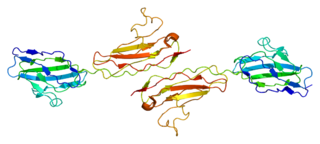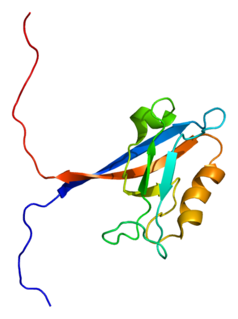This page is based on this
Wikipedia article Text is available under the
CC BY-SA 4.0 license; additional terms may apply.
Images, videos and audio are available under their respective licenses.

Occludin is a protein that in humans is encoded by the OCLN gene.
Occludin is a 65-kDa integral plasma-membrane protein located at the tight junctions, described for the first time in 1993 by Shoichiro Tsukita. Together with the Claudin group of proteins, it is the main component of the tight junctions.

Claudin-1 is a protein that in humans is encoded by the CLDN1 gene. It belongs to the group of claudins.

Claudin 4, also known as CLDN4, is a protein which in humans is encoded by the CLDN4 gene. It belongs to the group of claudins.

Junctional adhesion molecule A is a protein that in humans is encoded by the F11R gene. It has also been designated as CD321.

Claudin-5 is a protein that in humans is encoded by the CLDN5 gene. It belongs to the group of claudins.

Claudin 3, also known as CLDN3, is a protein which in humans is encoded by the CLDN3 gene. It is a member of the claudin protein family.

Claudin-7 is a protein that in humans is encoded by the CLDN7 gene. It belongs to the group of claudins.

Claudin-6 is a protein that in humans is encoded by the CLDN6 gene. It belongs to the group of claudins.

Claudin-2 is a protein that in humans is encoded by the CLDN2 gene. It belongs to the group of claudins.

Gap junction alpha-3 protein is a protein that in humans is encoded by the GJA3 gene.

Claudin-8 is a protein that in humans is encoded by the CLDN8 gene. It belongs to the group of claudins.

Cingulin is a cytosolic protein encoded by the CGN gene in humans localized at tight junctions (TJs) of vertebrate epithelial and endothelial cells.

Cingulin-like 1, also known as paracingulin or junction-associated-coiled-coil protein (JACOP), is a protein which is encoded by the CGNL1 gene.
The membrane-associated guanylate kinases (MAGUK) are a superfamily of proteins. The MAGUKs are defined by their inclusion of PDZ, SH3 and GUK domains, although many of them also contain regions homologous of CaMKII, WW and L27 domains. The GUK domain that they have is structurally very similar to that of the guanylate kinases, however it is known to be catalytically inactive as the P-Loop which binds ATP is absent. It is thought that the MAGUKs have subfunctionalized the GUK domain for their own purposes, primarily based on its ability to form protein–protein interactions with cytoskeleton proteins, microtubule/actin based machinery and molecules involved in signal transduction.
Tight junction proteins (TJs) are molecules situated at the tight junction of epithelia, endothelia and myelinated cell. This mutliprotein junctional complex has a regulatory function in passage of ionts, water and solutes throught the paracellular pathway. It can also coordinate the motion of lipids and proteins between the apical and basolateral surfaces of the plasma membrane. Thereby tight junction conducts signaling molecules, that influence the differentiation, proliferation and polarity of cells. So tight junction plays a key role in maintenance of osmotic balance and trans-cellular transport of tissue specific molecules. Nowadays is known more than 40 different proteins, that are involved in these selective TJ channels.















